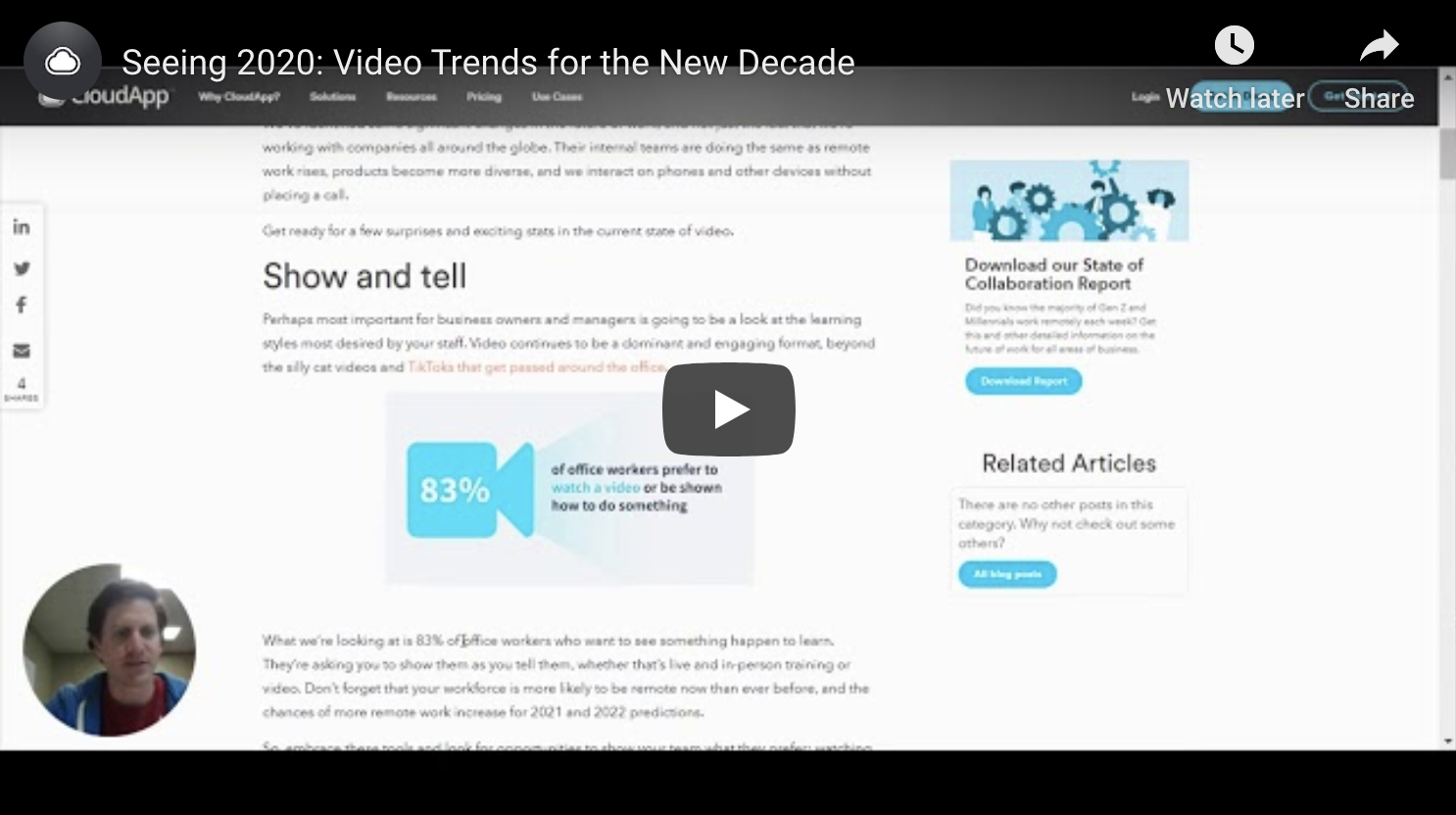Comments (3)
Adam Potts
Funny videos are my favourite ones
Lee Dearman
Thanks for sharing
Richy Johnson
Good read

Seeing is believing and, apparently, seeing is also working. The importance of visuals in the way we work and what we share is staggering, and it’s only growing according to the latest Video Trends in 2020 report from CloudApp.

We’ve identified some significant changes in the future of work, and not just the fact that we’re working with companies all around the globe. Their internal teams are doing the same as remote work rises, products become more diverse, and we interact on phones and other devices without placing a call.
Get ready for a few surprises and exciting stats in the current state of video.
Perhaps most important for business owners and managers is going to be a look at the learning styles most desired by your staff. Video continues to be a dominant and engaging format, beyond the silly cat videos and TikToks that get passed around the office.
What we’re looking at is 83% of office workers who want to see something happen to learn. They’re asking you to show them as you tell them, whether that’s live and in-person training or video. Don’t forget that your workforce is more likely to be remote now than ever before, and the chances of more remote work increase for 2021 and 2022 predictions.
So, embrace these tools and look for opportunities to show your team what they prefer: watching training, including via video. People are also better at learning and remembering when they have visuals as well as text, which means learning-style preferences actually match up with what works best for training.
Give your team what they want and use the tools that make it easy to create screen sharing, screengrabs, and video clips that you can use in multiple ways.
The 2020 video trend for learning style gives us a few more insights into how businesses might want to structure their content for internal teams and customers. First, a quick reminder that the 2019 report found a majority of customers prefer to learn through videos.
In the recent update, CloudApp data notes that Millennials are 2x more likely to learn from a blog post compared to older generations, Gen X and Boomers. That’s big, whether you’re in the B2B or B2C space.
For B2C companies, it’s most likely that the majority of your employees are Millennials or are trained by Millennials. At the same time, they’re the largest generation and spending a significant amount in today’s market. It’s all about how you look at the target demo and cater to their needs. For example, Millennials are expected to spend 37% more than the average adult this Valentine’s Day.
Video animation for dentists can play a smart role in the overall marketing, especially if your services require education. If knowledge can help sell your service, increase those blog posts!
In the B2B space, Millennials are important for two big reasons: they’re the largest generation in the U.S. labor force and have risen in their carriers to be involved in many purchase decisions. The research, suggestions, and even questions on integrations and other capabilities are going to come from Millennials. That means blogs are important for your long-term viability and sales.
You can leverage the power of video to turn these blog posts into full training paradigms for your teams as well as site visitors. Record steps, tricks, and tips, and put them at the top of your posts. In the body, explain what you’re doing and give greater context, so your audience can accomplish training and learning goals all in one easy-to-find location.
There are opportunities to look beyond generational information too. The new report shows that men and women approach learning differently. Each may give you thoughts on how to structure your content and where it’s available on your site or within your knowledge base.
Approaching from a high level, we can see that men are more inclined to watch first, and that likely means they’re searching for a “how-to” video first as well. The positioning for your how-to content, including perhaps the idea to put videos on YouTube or even look for sponsorships and DIY influencers, should cater to attempts at discovery.
Craft general training videos on a wide range of topics and linking them can help you capture attention and keep these visitors coming back for additional help. By being helpful without getting in the way, you can also earn more sales with this demographic.
For women in the study, their preference leans slightly toward asking someone to show them how to accomplish a task. If your target demo is female, then you can structure the introduction to content to respond to this cue. Acknowledging questions, difficulties with tasks, or encouraging someone to try something new can all be positive ways to incorporate a question and address the desired knowledge.
Importantly, here you’ll want to ensure that all of your sales and service channels are aware of content and demos so they can share. Asking for help can occur in a wide range of ways. Sometimes, that will be searching for questions or tips, while they may also directly ask you.
Teach your chatbots how to respond to frequent questions and learning needs for your products or services. Give service agents scripts that encourage asking questions and learning more information to ensure that this is a positive experience.
The goals of your video are to engage your audience in the way they prefer to learn. If you have a great teacher on staff, consider having them record your how-to. Then, you can combine that with multiple opening segments to create videos that either encourage jumping right in or set up the content and thank the viewer for asking for help.
If video isn’t your favored approach, you’re still in great shape for creating and using visuals. One of the most common forms of visual we see in an office setting is the screenshot. And, if you’ve spent any time on Twitter or other social media, you know that screenshots are an incredibly common way of sharing information, hot takes, and more.
We’re in a screenshot society, so it’s time for your business to join.
There’s a lot to review here, but perhaps most important is what we can infer from the data: the majority of your workforce is taking screenshots and some people are making a lot of them. Baby Boomers are least likely to take a screenshot at work, but we know that 60% of them still do this at least once a week. It only grows from there.
What really blows me away is that 33% of the office workforce is taking more than 15 screenshots a week. That shows people are using them as a knowledge tool, whether they’re sharing information, asking for help, or creating a record.
Looking at my own set of screenshots taken and received over the past week, I see employees asking for support, people celebrating big wins, quick recaps of the most important intelligence from dashboards, and relevant questions and quotes from the news and books.
The teams who utilize these most and take them to the next level in terms of usefulness are also annotating the screenshots — a few even turn them into GIFs so they can provide multiple comments. It’s a simple and direct way to highlight a topic, provide a comment, and then make an ask.
Something as simple as highlighting a competitor’s ad and then asking, “how do we beat this?” gets an entire marketing team going. And, it’s a piece of content that took a few seconds to see, grab a screenshot, and then layer the question on top.
A big theme in those discussions on screenshots, videos, and how-to’s is collaboration. Your teams want to collaborate and doing so makes them more effective at their work. It can also boost morale when collaboration is easy, and leadership celebrates it.
So, why not encourage it?
Visuals are a direct way to improve your team’s collaboration. This is especially true for a remote workforce. When your team is dispersed, they need technology to support interactions. If visuals help more than just text or audio, level them up to address the challenge with simple, effective tools.
It’s all part of the collaboration 2.0 movement.
Take some time and ask your team what they need, what they know, and gauge their willingness to learn something new. It’ll help you identify the right mix of tools to move forward.
Social video is useful for looking a little more specifically at interactions and helpfulness on your marketing side. It answers questions on what your customers are consuming, how much, and what you might be able to use to drive traffic to campaigns, pages, or assets.
Large consumption of social video is common, especially when you bring in YouTube. While the CloudApp study notes a significant younger presence in the social video landscape, other data also shows that the 35+ and 55+ age groups are the fastest growing YouTube demographics. Given that the site streams more than 5 billion videos per day, that’s a large and growing consumption for all age groups.
The technology gap here might not be as big as it seems. Data points to the potential that the gap is consumption/usage and not a lack of understanding or an inability to operate the tech. That’s great news for anyone who has workers and customers in a wide range of age groups.
Just like we saw with the how-to video segment, we again see men taking the lead in consumption. Men, on average, will watch 20% more video content than women. This might mean your best bet in attracting this audience or working with male team members is to build video that can be consumed and shared. It’s also worth noting that this is a larger trend on channels — for example, 62% of YouTube users are male.
If you want to respond to those groups, especially on social, create content that meets their desires. The social video landscape is a little different from other media and it’s worth noting that.
For instance, 83% of people want a video that focuses on happiness and humor. They want to get a lift from the content and have it be something they can share. Those elements actually feed into the four big reasons people share content:
That positivity isn’t always the focus of other forms of media because social video plays a significant role in how people connect today. If you want to see the counterpoint, check out Bong Joon Ho’s “Parasite” thriller that picked up four Oscars and was the first non-English language film in Oscar history to win the award for Best Picture.
Funny videos are my favourite ones
Thanks for sharing
Good read
Joe is VP of Corporate and Demand Marketing at Scorpion. He is also the CMO of Stockchain Global and Advisory Board Member at Ylixr. He has over 12 years experience managing various areas of marketing including research, media buying, social, and overall strategy. His analyses have been featured in the New York Times, Wall Street Journal, CNBC, Associated Press, and Forbes. Joe holds a BSc in Finance and MBA in Strategy & Marketing from the University of Utah. He also has an Executive Degree in Entrepreneurship and Innovation from the Stanford University Graduate School of Business.
Leave your comments
Post comment as a guest